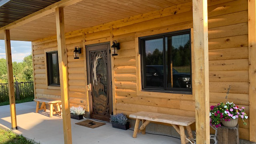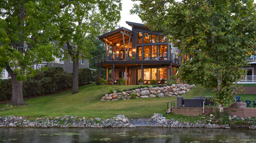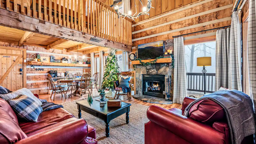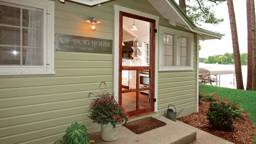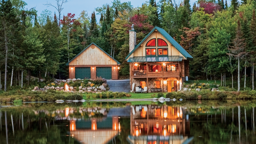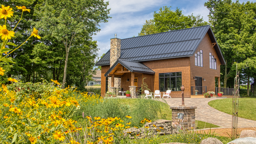Ideas galore
That tie to nature and the land was something that guided Ruth and became the theme as the cabin took shape. The planning and building process would require a delicate balance of nature, site and architecture.
She hired John Anderson of JDA Design Architects the next spring and they worked for six months designing a log home. That fall, Ruth hired Duane Sellman of Sellman Log Structures to build the hand-crafted log cabin. Architect and builder shared a philosophy of creating a place that would look as if it might have grown out of the ground.
There was a free flow of ideas as the building process began. The dimensions of the hallway grew in order to avoid congestion inside the back entrance. The floorplan was flipped so the sunroom could take advantage of the view over the bay. Ruth’s art studio on the second floor gave way to an expanded bunk room for the grandkids.
Often, it was a fantastic-looking log that sparked a change. One of these was the remnants of a giant spruce tree with six sturdy, sprawling branches, a tree that had lain in Duane’s log yard for three years just waiting for the right house.
Duane mentioned the tree to Ruth, and together they came up with the concept of a tree sculpture in the bunk room. It was perfect! But the giant spruce took up a lot of space, spilling over into the art studio. So, you see, there was no choice – the art studio had to go.
Putting character to work
Duane and the team looked for ways to use other uniquely shaped logs that had been collecting on Duane’s property. It became like a puzzle, matching these odd-looking former trees with specific areas in the house.
Character logs filled in areas of the building plan. For instance, the plans would call for a “fireplace,” but it wasn’t until a curved half-log was chosen as a mantel that the native rock underneath it took shape, repeating the mantel’s curvy shape.
A white oak tree with nicely formed limbs, turned upside down, became the stunning king post of a truss right inside the front entrance.
In several places, a wall log had such an interesting look that the team chose to leave it intact rather than cut it flush with the wall.
Building this way takes a creative eye and a lot of experience. As they worked, the team used the TLAR system: That Looks About Right. It means using common sense and experience when matching log, function and aesthetics. In addition, there are safety standards to be met and building inspections to be passed.
Duane and the team looked for ways to use other uniquely shaped logs that had been collecting on Duane’s property. It became like a puzzle, matching these odd-looking former trees with specific areas in the house.
Character logs filled in areas of the building plan. For instance, the plans would call for a “fireplace,” but it wasn’t until a curved half-log was chosen as a mantel that the native rock underneath it took shape, repeating the mantel’s curvy shape.
A white oak tree with nicely formed limbs, turned upside down, became the stunning king post of a truss right inside the front entrance.
In several places, a wall log had such an interesting look that the team chose to leave it intact rather than cut it flush with the wall.
Building this way takes a creative eye and a lot of experience. As they worked, the team used the TLAR system: That Looks About Right. It means using common sense and experience when matching log, function and aesthetics. In addition, there are safety standards to be met and building inspections to be passed.
PUTTING A GOOD CHARACTER LOG TO USE
• On the deck, a notch branch was cut flat so it could hold a drink, or a plate of nachos.
• In the half-bath, towel racks are fashioned from twigs.
• A 40-foot wall log extends from Ruth’s bedroom onto the back porch – a great spot for hanging towels to air dry or a lantern to light the way from the beach.
• In the hall, a birch branch provides a hanging spot for a chandelier (photo above).
• In the kitchen, the cut end of one log was the perfect place to hang a clock.
• A curved half-log forms the mantel for the fireplace on the screened porch. A mason shaped the fireplace to match the curve.
A cabin full of stories
Ruth’s cabin started out with dozens of stories: how the giant red pines that make up most of the cabin’s walls were trucked in from a watershed project 15 miles away; how the king post for the great room was dragged out of a swamp; how some of the logs used in the house were the casualties of a nearby tornado.
As the family spends more time at the place, the cabin continues to collect stories.
Two hat trees in the dancehall-sized hallway hold an extensive hat collection, which provides favorite dress-up props for the grandkids.
From the giant bunk room above, the kids make a game of tossing their sheets over the railing to land right at the laundry room door. And it’s not unusual for the kids to push all nine beds into the center of the bunk room for easier chatter at night.
There are s’mores made every evening in the wood-burning fireplace on the screened porch. And tales are retold there of fish caught and wild animals spied in the forest.
And the peculiar trees within the cabin watch over all, ready to inspire stories of their own.
Ruth listens and watches and settles back. And she’s come to realize, you will never be alone in a cabin full of character logs.
Ruth’s cabin started out with dozens of stories: how the giant red pines that make up most of the cabin’s walls were trucked in from a watershed project 15 miles away; how the king post for the great room was dragged out of a swamp; how some of the logs used in the house were the casualties of a nearby tornado.
As the family spends more time at the place, the cabin continues to collect stories.
Two hat trees in the dancehall-sized hallway hold an extensive hat collection, which provides favorite dress-up props for the grandkids.
From the giant bunk room above, the kids make a game of tossing their sheets over the railing to land right at the laundry room door. And it’s not unusual for the kids to push all nine beds into the center of the bunk room for easier chatter at night.
There are s’mores made every evening in the wood-burning fireplace on the screened porch. And tales are retold there of fish caught and wild animals spied in the forest.
And the peculiar trees within the cabin watch over all, ready to inspire stories of their own.
Ruth listens and watches and settles back. And she’s come to realize, you will never be alone in a cabin full of character logs.
CHARACTER LOGS CAN BE USED FOR . . .
• Posts
• Railings
• Rafters
• Accents
• Trim
• Newell posts
• Mantels
• Structural supports
Editor in Chief Diana Faherty believes that every tree has a story to tell, and a log house is like a living library.
THE TEAM:
• John Anderson, JDA Design Architects, Minneapolis, Minn., (612) 332-4525, www.jdadesign.com.
• Duane L. Sellman, Sellman Log Structures, Forest Lake, Minn., (651) 464-3843.
• Cary Johnson, Kelly Creek Logbuilding, Harris, Minn., (320) 358-3403.
• Noble Handley, Handley Construction, Center City, Minn., (651) 257-4982.
THE TEAM:
• John Anderson, JDA Design Architects, Minneapolis, Minn., (612) 332-4525, www.jdadesign.com.
• Duane L. Sellman, Sellman Log Structures, Forest Lake, Minn., (651) 464-3843.
• Cary Johnson, Kelly Creek Logbuilding, Harris, Minn., (320) 358-3403.
• Noble Handley, Handley Construction, Center City, Minn., (651) 257-4982.
They’ve stood their ground for generations, the two giant columns that support the roof over the front porch: first as oak trees on the property, now, as sentries at the entrance to this family’s dream cabin.
Sturdy and proud – and a bit gnarly. Their upper limbs spread to support the sloping copper-clad roof. It’s almost as if they’re still growing out of the ground and the cabin porch was carefully positioned between them.
In the parlance of log homebuilders, these are called character logs. Logs that aren’t straight or true or perfect. Logs that have gnarls and bumps and forks. Logs that would be rejected by builders because they don’t stack well, and by sawmills because they’re too crooked for making boards. But in the hands of a skilled craftsman, they can infuse life and laughter into any home.
Sturdy and proud – and a bit gnarly. Their upper limbs spread to support the sloping copper-clad roof. It’s almost as if they’re still growing out of the ground and the cabin porch was carefully positioned between them.
In the parlance of log homebuilders, these are called character logs. Logs that aren’t straight or true or perfect. Logs that have gnarls and bumps and forks. Logs that would be rejected by builders because they don’t stack well, and by sawmills because they’re too crooked for making boards. But in the hands of a skilled craftsman, they can infuse life and laughter into any home.
FINDING A SPOT FOR UNIQUE LOGS
• In the sunroom, one forked log was placed so that one of the branches is inside, the other one outside.
• A tie beam in the kitchen was set kitty-corner so as not to interfere with the “clock log.”
• In the main bath, beaver chews shape the ends of the towel hooks.
• A wall log in the great room is an extension from one of the bedrooms. Its natural arch frames the doors that lead out to the back deck.
• A white pine that wraps around itself is a support post on the screened-in porch.
• Logs with character spots such as burls, scars or nubs are best placed high or low in a wall.
Otherwise, the unique spots are more likely to be covered up by photos or other wall hangings.
• A particularly twisted tree anchors the railing at the top of the stairs (photo above).
The sign of the geese
Ruth Holdridge didn’t set out to build a showcase cabin. In fact, she didn’t even want to build. She simply wanted to find a place where her far-flung family could gather for holidays, or retreat to on weekends and for extended vacations.
Because there was no cabin on this 7-acre parcel on the shore of a private, spring-fed lake, the property was not at the top of Ruth’s list. In fact, Ruth was ready to dismiss this piece of land. But her daughter Nancy felt something. She persuaded her mother to at least entertain the idea of building there, and the two women visited again.
It was fall, with the trees in their autumnal flame of colors. As the two women approached the lakeshore, they saw thousands of Canada geese covering the east end of the lake, taking a break from their migratory flight south. As if on cue, the birds started to take flight, thousands of 2-foot-long wings carrying this giant, honking flock into the air.
It was a sign, says Nancy.
Ruth took a deep breath and bought the land.
Ruth Holdridge didn’t set out to build a showcase cabin. In fact, she didn’t even want to build. She simply wanted to find a place where her far-flung family could gather for holidays, or retreat to on weekends and for extended vacations.
Because there was no cabin on this 7-acre parcel on the shore of a private, spring-fed lake, the property was not at the top of Ruth’s list. In fact, Ruth was ready to dismiss this piece of land. But her daughter Nancy felt something. She persuaded her mother to at least entertain the idea of building there, and the two women visited again.
It was fall, with the trees in their autumnal flame of colors. As the two women approached the lakeshore, they saw thousands of Canada geese covering the east end of the lake, taking a break from their migratory flight south. As if on cue, the birds started to take flight, thousands of 2-foot-long wings carrying this giant, honking flock into the air.
It was a sign, says Nancy.
Ruth took a deep breath and bought the land.


 Tanya Nygren
Tanya Nygren 
 Tanya Nygren
Tanya Nygren  Tanya Nygren
Tanya Nygren  Tanya Nygren
Tanya Nygren 




